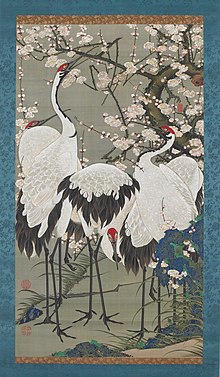Itō Jakuchū
Itō Jakuchū ( Japanese 伊藤 若 冲 ; March 2, 1716 to October 27, 1800 ), real name Shunkyō ( 春 教 ) and / or Jokin ( 汝 鈞 ), was a Japanese painter of the middle Edo period , who was known mainly because of his chickens - and other bird pictures has remained known.
life and work
Jakuchū was the eldest son of a rich greengrocer named Itō Genzaemon, who ran a shop on Nishiki-no-kōji in Kyoto under the name Masuya ( 枡 屋 ). After the death of his father, Jakuchū took over the shop and also painted. He first studied under Ōoka Shumboku (1689–1763), a painter of the Kanō school . Dissatisfied with the Kanō school, which at the time put emphasis on copying earlier masters, he turned to the Chinese painting of the Song and Yuan periods . Eventually, direct observation of the animals and plants around him became the source of his inspiration.
In 1754 he handed the business over to his younger brother and devoted himself entirely to painting. To this end, he built a two-story studio on the west bank of the Kamo River and called it Shin'en-kan ( 心 遠 館 , "Villa of the carefree heart or mind"), a quote from a poem by the famous Chinese poet Tao Qian . In a period of more than ten years he completed a series of 30 pictures under the title “Colored Pictures of Animals and Plants” ( 動 植 彩 絵 , Dōshoku saie ) and a three-part work under the title “Buddha and Companion” ( 釈 迦 三 尊像 , Shaka sanzon-zō ), which he donated to Shōkoku-ji , an important temple in Kyōto and his residence after 1788. During this time he was also busy painting sliding doors and walls ( 障 壁画 , shōhekiga ). In the directory of important personalities in Kyoto, the Heian jinbutsu-shi ( 平安 人物 誌 ), from 1768 Jakuchū is named third.
After he was 60, he devoted a lot of time to erecting stone sculptures, such as those of the 500 Arhat , which were erected on a hill behind the Zen temple Sekihō-ji in the Fukakusa district (Kyoto). In order to get the necessary funds for this, he sold a large number of ink drawings. Half of Jakuchu's existing paintings date from this period.
Many of his pictures show chickens in a realistic manner, so that he was also called the "chicken painter". But in his later years he continued to paint interiors in the style of Rimpa painting . Jakuchū also produced stone prints using the ishizuri technique, whereby colored items are printed on a dark background. There are also woodcuts as book illustrations by him.
In addition to the 30 paintings mentioned, which are in the possession of the imperial family, the interior of the abbot's quarters of Kinkaku-ji in Kyoto, the Okushoin of the Kotohira shrine on Shikoku and the Saifuku-ji in Osaka should be mentioned.
technology
Only the most recent investigations reveal the amazing craftsmanship that is hidden behind Jakuchū's pictures. He was able to work without preliminary or outline drawings or subsequent corrections and to draw details with a distance of less than 0.1 mm. He partially painted the canvas from the back to achieve special effects. With just a few basic colors, he was able to produce an enormous variety of colors by juxtaposing the smallest of colored dots; the colors only emerge in the eye of the beholder (comparable to the color image produced by a cathode ray tube or a flat screen). His technique of creating three-dimensional impressions with the help of small squares can also be described as a “digital effect”.
"In a thousand years my pictures will be understood."
photos
A screen of the 36 Immortal Poets
literature
- Satō, Yasuhiro: Itō Jakuchū . Tokyo Bijutsu, 2006. ISBN 4-8087-0793-4 .
- S. Noma (Ed.): Itō Jakuchū . In: Japan. An Illustrated Encyclopedia. Kodansha, 1993. ISBN 4-06-205938-X , p. 637.
- Tazawa Yutaka: Biographical Dictionary of Japanese Art . Kodansha International, 1981. ISBN 0-87011-488-3 .
- Laurance P. Roberts: A Dictionary of Japanese Artists. Weatherhill, 1976. ISBN 0-8348-0113-2 .
Web link
Individual evidence
- ^ Marie Yanaka: Reality or Imagination? In: NHK World . April 27, 2016, accessed on February 7, 2017 (report on an exhibition in Tokyo on the occasion of his 300th birthday).
- ↑ "Jakuchu: The Divine Colors" (documentary, broadcast on NHK World and Others on 4 February 2017th.)
- ↑ JAKUCHU: The Divine Colors. (No longer available online.) In: NHK World . June 26, 2016, archived from the original on March 22, 2017 ; accessed on February 7, 2017 (English). Info: The archive link was inserted automatically and has not yet been checked. Please check the original and archive link according to the instructions and then remove this notice.
| personal data | |
|---|---|
| SURNAME | Itō, Jakuchū |
| ALTERNATIVE NAMES | 伊藤 若 冲 (Japanese); 伊藤 春 教 (real name, Japanese); Itō Shunkyō (real name); 伊藤 汝 鈞 (real name, Japanese); Itō Jokin (real name) |
| BRIEF DESCRIPTION | Japanese painter |
| DATE OF BIRTH | March 2, 1716 |
| DATE OF DEATH | October 27, 1800 |






